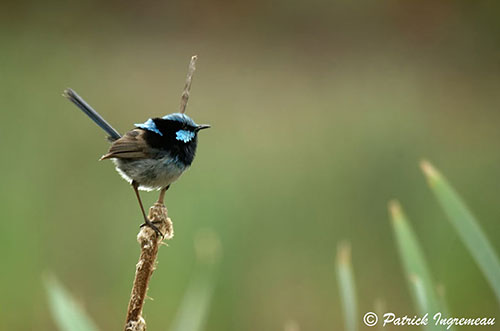
TO BE CONTINUED... Page 9 under constrution...
Text by Nicole Bouglouan
Photographers:
Aurélien Audevard
OUESSANT DIGISCOPING
Jean Michel Fenerole
Photos d’Oiseaux du monde
Patrick Ingremeau
TAMANDUA
Ian McHenry
My New Zealand Birds
Otto Plantema
Trips around the world
Dubi Shapiro
Dubi Shapiro Photo Galleries
Simon Tan
PBase Bird galleries
Illustration: Rufous-crowned Emu-wren
John Gerrard Keulemans : 1842-1912
Source : Ibis Journal (1899)
These images and the text are subject to copyright and cannot be used without express authorization from the owners. Legal issues
Sources:
HANDBOOK OF THE BIRDS OF THE WORLD Vol 12 by Josep del Hoyo-Andrew Elliott-David Christie - Lynx Edicions - ISBN: 8496553423
HANDBOOK OF THE BIRDS OF THE WORLD Vol 13 by Josep del Hoyo-Andrew Elliot-Jordi Sargatal - Lynx Edicions – ISBN: 9788496553453
The Cornell Lab of Ornithology - Birds of the World
Fatbirder - The World’s Richest Information Resource about Birds for Birders
CREAGUS@Monterey Bay (Don Roberson)
Wikipedia, the free encyclopaedia
The bird and its nest, where everything starts…
Second part: The Passerines – Order Passeriformes
Page 8: Maluridae, Meliphagidae
At the beginning of the breeding season and following several courtship displays, the nest-site is selected by the pair, or one of the members of the pair, and the nest is built within this area. For numerous species, the nest is the place where displays and copulation occur. It plays a very important role during the nesting period. It is the cradle of the chicks, the place where the adults feed them prior to their first flight towards independence.
The family Maluridae includes 27-29 species depending on the authors. These small, insect-eaters passerine birds are found in Australia and New Guinea from which they are endemics. They are named fairywrens, emu-wrens and grasswrens, but they are not related to the true wrens of the Northern Hemisphere.
The New Guinean species have been little studied.
They frequent grasslands, deserts, rainforests and scrubby areas, and generally occur from arid shrublands to tropical forests, but they often favour habitats with dense vegetation growing to about two metres in height.
The grasswrens, have fairly cryptic plumage with black and brown patterns, whereas other species show bright-coloured plumages with bright blue or reddish patches, especially in males. The wings are short and rounded, and the long tail is often cocked over the back. These birds often adopt an upright posture.

All members of the family are primarily insectivorous. During winter, when insects are scarce, these gregarious birds spend most of the day foraging throughout the territory. They also feed on seeds and fruit.
Like other Australian Maluridae, the Red-backed Fairywren hops along open ground and forages under the vegetation. It pounces on prey as soon as it is located, and probes leaf litter or gleans from leaf or stem. When it feeds in shrub, it hops from branch to branch while gleaning from leaves and bark. It may also flutter through the vegetation to disturb prey, and then, it pursues them.
In summer, when insects are abundant, they have more time for resting in groups, perched side by side, performing mutual preening in shady site between two foraging periods. Then, at the end of the day, after foraging while singing loudly, the groups move to dense shrubs to spend the night, always perched close to each other in body contact with the neighbours, along a horizontal branch.
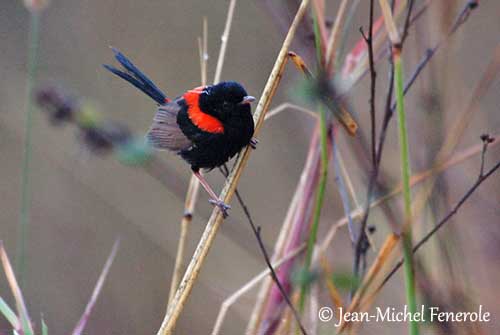
The Maluridae have pleasant but complex songs. Both fairywrens and emu-wrens give a song of 2-5 seconds, sometimes longer in some species, rather mechanical than musical and melodious.
The song of the grasswrens is much more complex, varied and melodious, and includes whistles, trills and buzzes.
All members of this family have numerous contact and alarm calls. Alarm calls are loud and noisy “chit” or “zit”, given singly or repeated, depending on the threat.
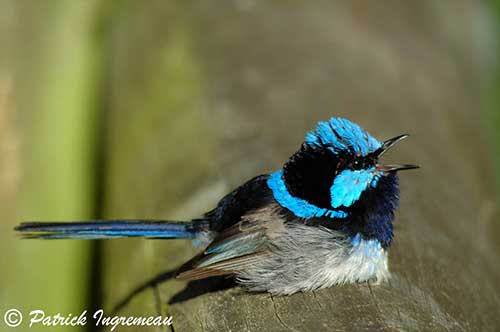
The Maluridae appear to live in groups and probably also perform co-operative breeding, involving the presence of both breeding and non-breeding mature individuals living in group. The non-breeding birds are “helpers” and take part to chick-feeding and chick-rearing, especially when they fledge and leave the nest. They also help in territory defence.
The males display their bright-coloured plumage. Like in the Superb Fairywren, the feathers of nape and mantle are fluffed out while the crown feathers are flattened. The male twists from side to side close to a female.
Usually, the courtship displays enhance the bright-coloured parts of the male’s body, including in display-flights.
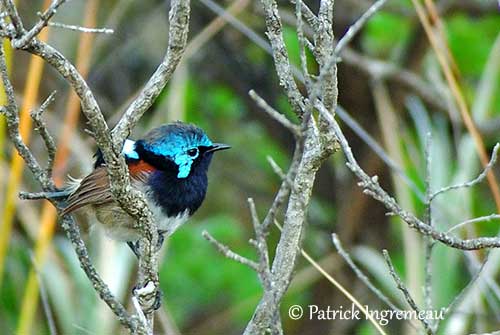
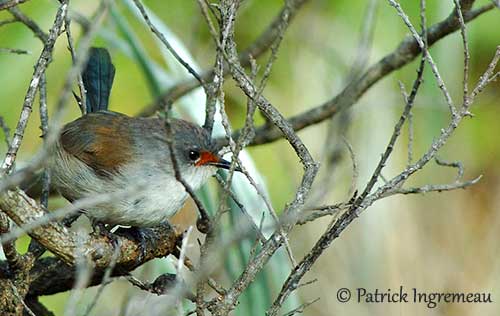
Red-winged Fairywren
Male
Red-winged Fairywren
Female
Some males may offer a coloured petal or a fruit to the female, in addition to the other displays. The colour of the gifts often contrasts with their plumage. The Superb Fairywren carries yellow petals, whereas the Splendid Fairywren prefers pink, blue or purple ones, occasionally yellow and white petals. The Red-backed Fairywren offers orange, red and yellow petals, but also red berries. It also erects the red feathers of mantle and scapulars during the displays.
Following the displays, the female may solicit copulation by crouching and fluttering her wings. She sings if the male is not close to her, and usually, it immediately approaches and mounts her.
The displays of both emu-wrens and grasswrens are poorly known, but the males appear to feed the females during some days before mating.
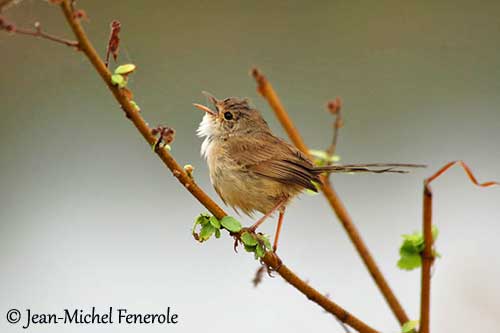
Red-backed Fairywren
Female
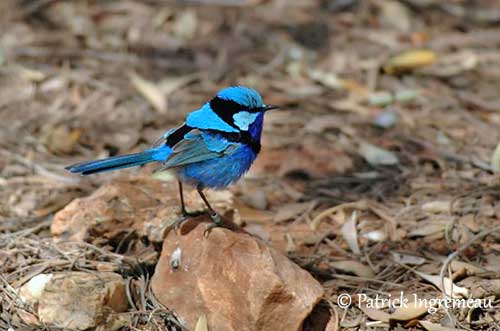
Most of them build a domed nest with a slight hood over the entrance. It is placed about 90 centimetres above the ground in palms near tropical river. The nest is bulky and resembles a pile of debris. The nest’s size is related to the size of the birds.
The nest of the Superb Fairywren is built in low, thick shrub, about one metre above the ground. It is a dome-shaped rounded nest with lateral entrance. It is made with loosely woven grasses and spider webs.
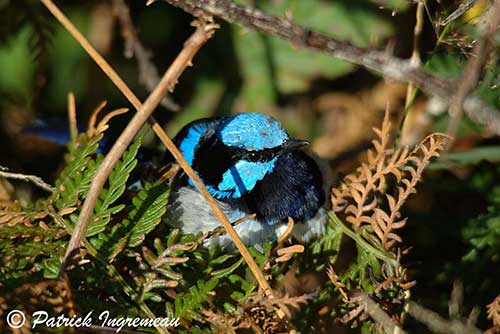
Emu-wrens and grasswrens build fairly similar nests, although some variations are observed.
The Thick-billed Grasswren builds almost an open cup, or with a partial hood, whereas others have a complete hood and a side entrance. It is built by the female. The thick walls are made with grass, twigs and strips of bark. The inner cup is lined with fine grass and plant down. It is placed about 30 centimetres above the ground in a shrub.
The nests of emu-wrens are similar in size and structure to the nests of the smaller fairywrens, and are usually domed with side-entrance.
In the Rufous-crowned Emu-wren, the female builds the nest, a woven structure made of grass stems and spider webs. The inner part is lined with plant down and feathers. It is placed at top or in centre of Triodia hummock (an endemic genus of Australia), only 20-25 centimetres above the ground. Depending on the species, other materials such as bark, leaves and moss can be used to build the nest.
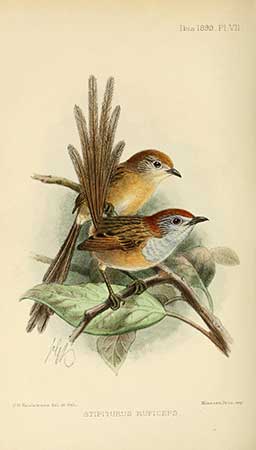
Rufous-crowned Emu-wren
John Gerrard Keulemans : 1842-1912
Source : Ibis Journal (1899)
The eggs of all species are fairly similar in appearance, varying from dull white to pinkish-white, with red-brown spots. They lay two to four eggs, usually three. Male, female and helpers feed and care the chicks, including after leaving the nest.
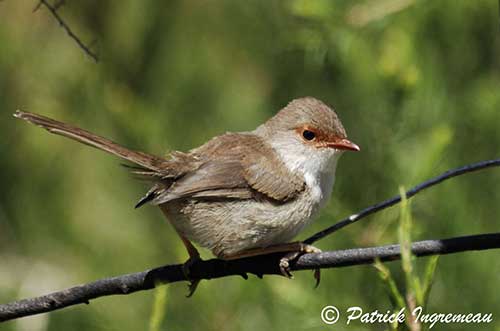
Female
Maluridae are affected by nest parasitism by cuckoos and predation by snakes and lizards, rats, feral cats and foxes, and some bird species.
They are threatened by destruction and degradation of their habitats due to an increased prevalence of fire. Some species have small, fragmented ranges particularly vulnerable to fire.
Introduced animals by humans destroy both nests and eggs, but they also kill the adults. These predators have now spread to most parts of Australia, including the arid areas.
About 70% of the species are evaluated as Least Concern, 6% are Near Threatened and 6% are Vulnerable.
The family Meliphagidae or Honeyeaters includes more than 190 species classified into 55 genera. They are most common in Australia and New Guinea, but some species are also found in New Zealand, the Pacific Islands, and Wallacea. There is a single species in Bali, the Indonesian Honeyeater.
They frequent a wide variety of habitats, from scrubland and woodland within Australia, to tropical rainforests in coastal Australia and New Guinea. The most important for these birds is the presence of flowering plants providing them nectar, fruits and insects. They are closely associated to the Australasian flora, and both honeyeaters and flora depend strongly from each other. The birds disperse the seeds of numerous plant species, but they also are important pollinators of trees and bushes. However, in spite of their similar appearance and behaviour, honeyeaters are unrelated to sunbirds and flowerpeckers.
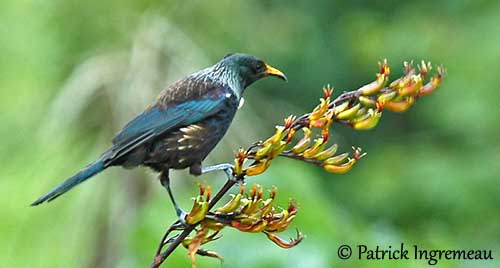
The Meliphagidae are medium-sized species with a total length of 15/25 centimetres. Males are typically larger than females in almost all species, and also have longer bill. The plumage varies from dull earth tones to contrasting bright-coloured patches on black plumage. The males of some species have brighter-coloured plumage than the females.
The birds are rather slim, with slender head and low sloping forehead and crown. Some ornaments such as wattles, ear-tufts, casques or bare patches are visible in several species. The bill is generally strong, and can be long and decurved, or almost straight in some species. The eyes are usually dark, although some birds have bright, contrasting eyes.
The robust legs and the tail are moderately long. The wings are long and pointed.
But these birds have a specialized feature in their mouth, with a brush-tipped tongue and structural modifications of the bill, well adapted to feed on nectar. But these features may vary between all species.
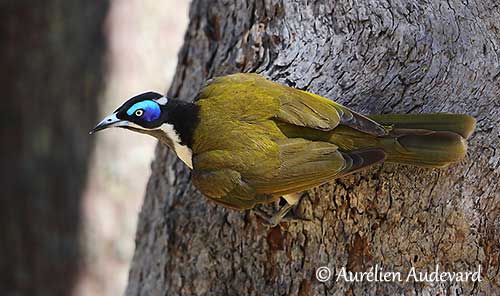
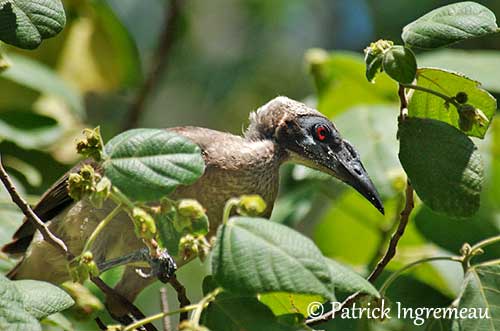
The Honeyeaters feed primarily on nectar from flowers, but they also consume insects, spiders, various arthropods, and fruits. Their morphology, and mainly that of the bill, reflects their diet and feeding behaviour.
The smaller, long-billed species feed mainly on nectar, whereas smaller, short-billed species feed more on insects. The larger, short-billed species include more fruits in their diet. In addition, the brush-tipped tongue has the tip divided into two, four or more clumps of bristles allowing the bird to take nectar easily.
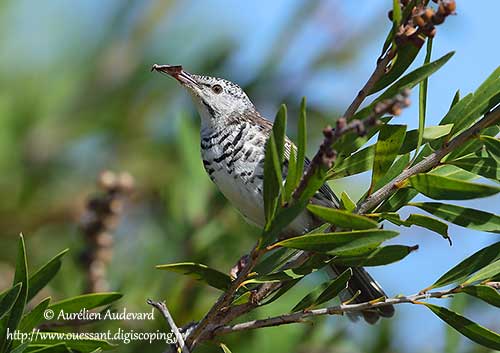
Honeyeaters are not very good for hovering flight, but some species such as the Noisy Miner catches numerous insects by sallies or even sally-hover. However, other species, especially the Scarlet Myzomela is able to hover when feeding at flowers, probably thanks to its small size. It usually probes for nectar when perched, but it can hover to access some hard-to-reach flowers. The Dusky Myzomela visits numerous flowers, and feeds actively and acrobatically. If necessary, it is able to hang upside-down to get the nectar.
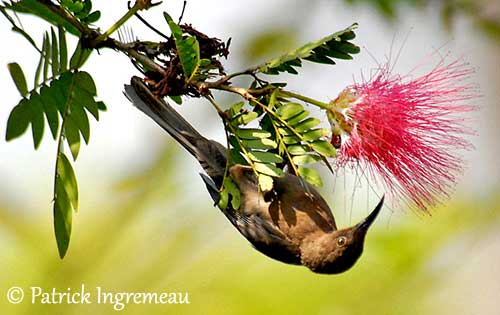
The Blue-faced Honeyeater has a very varied diet. It feeds on nectar by probing at flowers of genera Eucalyptus, Melaleuca and Grevillea. It often forages in small groups, searching for arthropods and small lizards, and fruits from native and exotic plant species.
The Tui of New Zealand prefers to extract nectar from short flowers with little curvature, with its stocky, slightly decurved bill.
Numerous species may travel some distance to find food, mainly nectar. They also defend the foraging areas where abundant sources of pollen and nectar may attract other birds.
Most honeyeaters prefer to drink while perched, but some of them such as the Red Wattlebird which are able to sally for insects, also drink in flight. The bird flies low over the water and rapidly ingests water before to fly off to a perch.
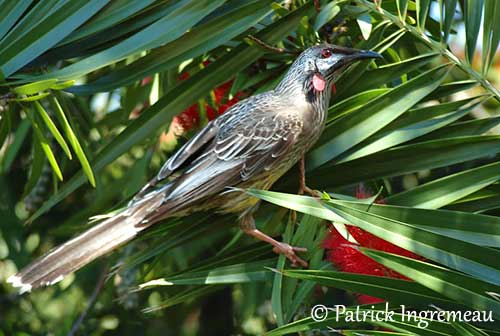
In such diverse family, the vocalizations are very varied. These birds have generally loud, strong and clear vocalizations with only a small proportion of musical and melodious sounds.
The New Zealand Bellbird is well known for its repertoire and its “bell-like” dawn-song. From a single note, the form, length and variation of the song are complex.
The song includes three distinct sounds, fairly similar to the chiming of bells. These “bell-notes” are mainly heard when several birds are present, and mostly at dawn and dusk. The birds may sing in perfect unison. Both mates also duet.
The alarm call is a series of loud “tink-tink-tink” rapidly repeated. We can also hear continuous whistling, squeaks and plaintive call.
The Noisy Miner has twelve different vocalizations in addition to a song. They vary from strident and whistling to scolding and chuckling. It utters loud “pwee-pwee-pwee” and a piping “pee-pee-pee” if disturbed or threatened. All members of the colony repeat these calls if alarmed. Various other calls include clicks, peeps and squeaks.
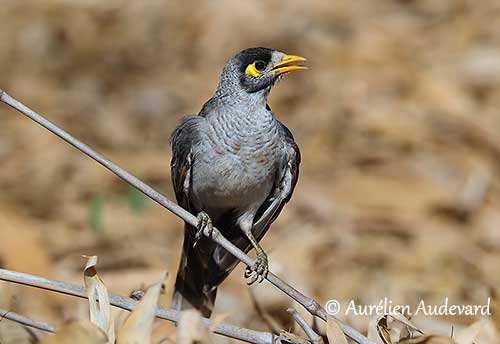
The friarbirds of genus Philemon have harsh and loud repertoire related to their pugnacious nature. The Helmeted Friarbird vocalizations differ geographically, as the species is distributed from the Lesser Sundas through New Guinea to Australia.
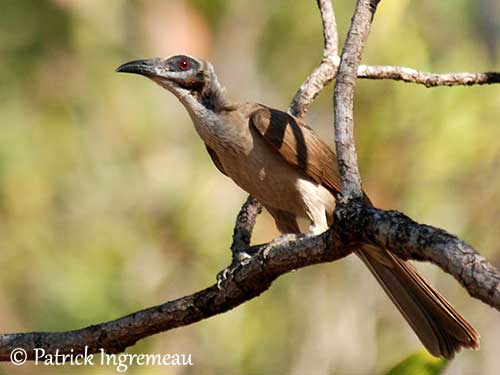
Honeyeaters also perform song flights during the breeding season. Some species fly high above the nest-site while singing loudly before to descend rapidly. These song flights are primarily viewed as sexual advertising rather than territorial displays. They are less common in New Guinea than in Australia and New Zealand.
However, the displays of honeyeaters are not well known. The repertoire of displays of many species seems to be fairly simple.
But some species, especially those of genera Phylidonyris and Lichenostomus performs their displays in groups with much calling and wing-fluttering. These ceremonies may occur from the ground to the canopy or other prominent places, and are sometimes performed at empty nests.
These displays named “corroborees” (from an Aboriginal term) are seen only at the beginning of the breeding season, and probably play a role in territory maintenance. This behaviour may include defence against predators and intruders, but it may also represent a demonstration of togetherness by the members of a group.
Co-operative breeding has been recorded for 20 species. Both adults and helpers take part in nesting duties such as chick-feeding, including the fledglings.
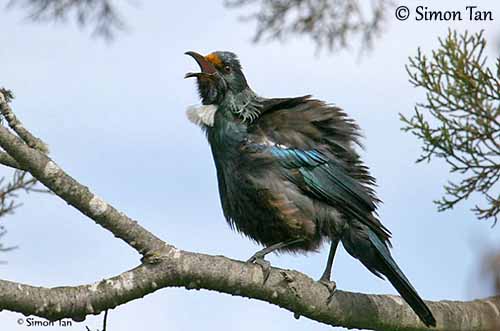
The breeding season seems to be long for most honeyeaters, involving several breeding attempts in a season. But the length of the season may vary according to the wide range and food availability.
Following nest-selection by male or female, the nest-building starts. Either adults or the female alone build the nest. In the latter case, the male remains close to the female but it does not gather material and does not help her. The nesting materials are collected around the nest, up to 200-400 metres away for the larger species, but much closer for the smaller species. Nest materials are found on the ground, around the base of shrubs and trees or around fallen trees, generally from live or dead vegetation. They are carried to the nest-site in the bill.
The nests of the Meliphagidae are almost universally cup-shaped or bowl-shaped, or similar to baskets.
But there are two exceptions, the two species of genus Ramsayornis that build domed nests. The Brown-backed Honeyeater builds a bulky, elongated, hanging and domed nest. There is a side entrance near the top and often a hood.
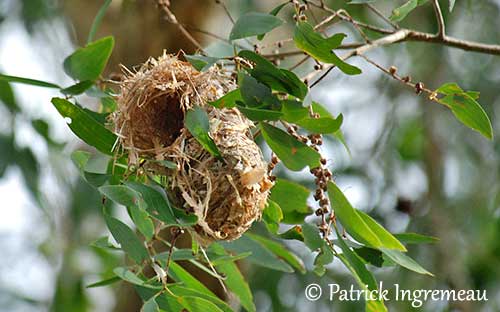
Brown-backed Honeyeater
Nest
The wattlebirds of genus Anthochaera build a typical deep, open cup, whereas the nests of the friarbirds are large, loosely built open cups or bowls.
The Blue-faced Honeyeater often uses the nests of other species, such as the large, domed stick nests of Grey-crowned Babbler but it may sometimes reuse old nests of other Meliphagidae species.
The nests of Rufous-throated Honeyeaters are neat, fragile and purse-shaped, suspended by one side from a fork of branch, and the unattached side of the rim is hanging lower.
The nests are usually attached to the nesting support by the rim. The size varies with the species.
Just to compare, the nest of the Scarlet Myzomela is a small, neat cup with an external diameter of about 5 centimetres and external depth of 3,8 centimetres, whereas the nest of the Helmeted Friarbird is a large, open cup with external diameter of 20-23 centimetres and depth of 18 centimetres.
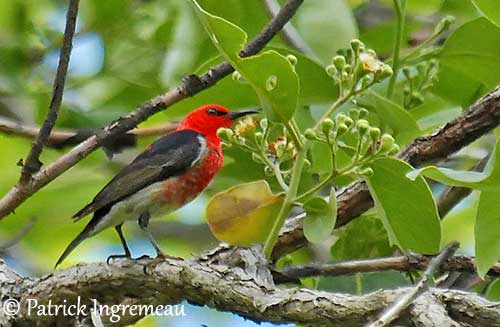
Various materials are used by honeyeaters for their nests. They are usually made from bark or bark fibre. The larger species use broad and large strips or pieces of bark in their nests, whereas the smaller species use finer and smaller strips or pieces of bark. Twigs and grass are common in nests with bark. The larger nests have more twigs or sticks, and smaller nests include much grass.
The cup structure includes leaves, casuarina and pine needles, fern fronds, stems and fibres, vine tendrils, rootlets, spider webs, and also soft material such as wool, feathers and fluffy seedheads. Foliage of the nesting plant is often incorporated into the sides of the nest, probably as camouflage.
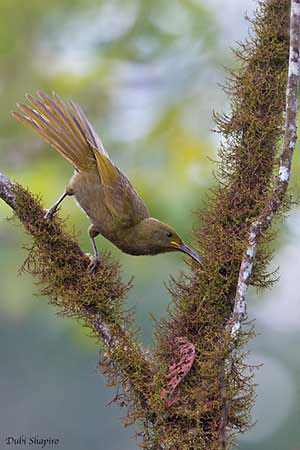
The outer part of the nest is sometimes covered with moss, lichens and other materials similar to the environment. We can also see spider eggs sacs and cocoons attached to the outside, and some nests may have loosely woven wool hanging outside from both sides and bottom.
Generally and depending on the species, the nests of honeyeaters are very well done and appear very pretty, neat and tidy.
Most of them are suspended by the rim from fork or branch in dense foliage. The large nests of the friarbirds are firmly woven on fairly thick branches while others can be suspended in vertical fork or cluster of twigs or branches.
They are usually built in live tree or shrub and the height varies from close to or occasionally on the ground, to 45 metres above in the crown of tall trees. Usually, most species build the nest between 3 and 6 metres above the ground, or lower according to the species.
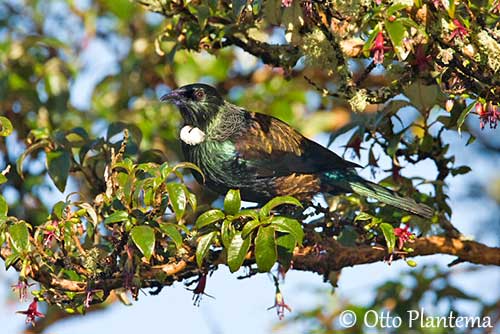
The honeyeaters, like the old endemic passerines of Australasia, have generally small clutches, but more studies are required. The most frequent clutch is of 2 eggs, and clutches of 3-4, and rarely 5 eggs are mainly laid by species of friarbirds and miners.
However, the two New-Zealand endemic have larger clutches of 3-4, and even 5 eggs. The poorly known island endemics of SW Pacific Ocean appear to lay a single egg.
Clutches larger than usual are probably the result of more than one female laying in the same nest. The eggs are oval and finely textured. The colour ranges from white, through cream and buff to pink and salmon with darker spots and blotches.
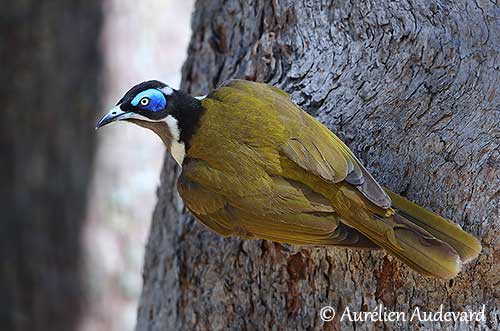
The female lays her eggs with intervals of 24 hours, but mostly 24-48 hours for the larger species. The incubation period ranges from 12 to 17 days, while the nestling period lasts 11 to 20 days, sometimes longer. These periods are related to the bird’s size, being short for smaller species and longer for larger species.
Incubation and brooding nestlings is usually carried out by the female, even among colonial and co-operative breeding. However, auxiliaries feed both nestling and fledglings, protect them from predators and remove or eat the faecal sacs.
The chicks are altricial and nidicolous. At hatching, they are blind and almost naked, but they are quickly covered in down. They are normally independent from 26 to 42 days after fledging, but more information is needed.
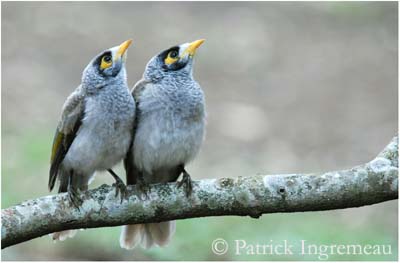
Juveniles
The nests of the Meliphagidae are threatened by numerous avian predators, but also by mammals and insects, human disturbance, parasites and diseases.
A rare Meliphagidae, the Crow Honeyeater, is Critically Endangered. It is found in New Caledonia and is rapidly declining, probably from predation by introduced rats.
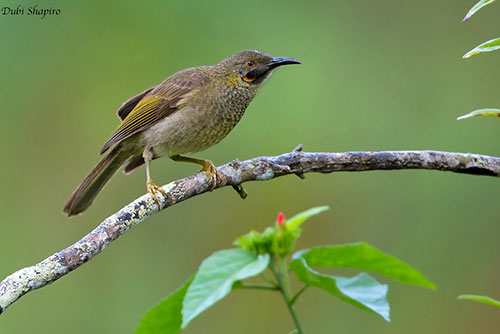
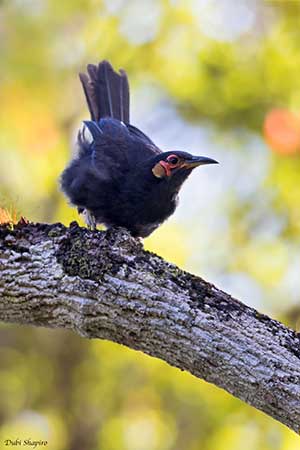
The endemic species are vulnerable to habitat changes. Both Australian Regent Honeyeater and Painted Honeyeater have large ranges, but they are affected by degradation of the habitat through clearing of Eucalyptus forest.
However, most Meliphagidae species do not face immediate conservation concerns.